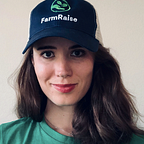From thoughts to leadership: making the leap in regenerative agriculture
I felt a spike of excitement this week when I heard Farmers Business Network (FBN) announce their Regenerative Agriculture Finance Fund, a new lending vehicle that rewards American farmers who implement soil health-building, “regenerative” ag practices with a reduced interest rate. This announcement caught my eye because at FarmRaise, we’ve been working hard to connect farmers with innovative sources of funding. FBN’s pilot may be modest ($25M in available capital out of approximately $90B+ in annual farm loan demand), but to scale regenerative agriculture, we need these baby steps to test and build a model that links the cost of capital to soil health.
Every month, it seems a new agriculture think tank study or op-ed makes the case for tying soil health to the cost of farm capital. It’s infinitely rarer for an organization to pilot a lending model that accounts for how regenerative practices reduce the riskiness and improve the profitability of farm businesses across the United States. FBN is making the tough but crucial leap to validate that soil health practices can favorably impact a farm balance sheet and is proving that farmers will use and benefit from this model.
As I chewed on the news, my excitement gave way to unanswered questions. To translate initial hope into meaningful, industry level action, the entire agriculture community — and farmers, in particular — deserve answers across the categories of scale, standardization, and stacking of capital.
Scale: this needs to be accessible by every American farmer
Farmers are inundated with announcements of agriculture startups, NGOs, and Fortune 500 companies committing capital, forming partnerships, and launching markets related to sustainability outcomes, but most farmers haven’t accessed these opportunities because the programs haven’t yet scaled. Change is slow, but in the U.S. agriculture industry, I’ve seen companies announce regenerative agriculture actions more effectively than they execute on them.
Getting a field report in real-time from the FBN pilot could boost morale and stoke farmer interest more than a press release. How does a 50 basis point interest rate reduction make a difference in a farmer’s bottom line? How is the reporting component of the loan impacting the farmer’s day-to-day operations? Has the farmer recommended the program to a friend? These are actionable insights that other farmers can evaluate to decide whether they want to sign up, and a bellwether for the rest of the industry to learn what’s working. Meaningful progress toward scale of these programs will be a breath of fresh air in a world of sustainability hype.
Standardization: who is the source of truth?
The Environmental Defense Fund (EDF) developed the metrics that FBN will use to measure sustainability on the farm, validated via FBN’s agtech platform Gradable. When it comes to industry standards, the EDF is one of the best-equipped organizations to define sustainability at the farm-level, but their voice is joined by many other credible organizations trying to set the standards for what farm sustainability means. In May 2021, the NGO LandCore announced a partnership with Compeer (a Farm Credit Association) to develop metrics that link the cost of farm loans to soil health. Add to this mix the Patagonia-endorsed Regenerative Organic Alliance developing benchmarks for a regenerative ag certification, and there’s a chorus of standards competing for press and farmer attention.
We need a leading standard so that farmers aren’t faced with ambiguity across lenders and markets. In the absence of a leading standard, this ambiguity could lead to a greenwashed “regenerative agriculture” redefined by every organization in the manner that best suits their interests. The U.S. Department of Agriculture may be the best poised actor to set this definition and eliminate competing standards before the term“regenerative” loses its power and meaning.
Stacking: show me the money
Each year, billions of dollars in public capital are allocated at the district, state, and federal level to further support farmers in transitioning to regenerative practices. A regenerative agriculture loan will go considerably further when stacked with these public opportunities. I’m biased because this is what we do at FarmRaise, but regardless of how a lender chooses to stack funding, this is a massive opportunity for both the lender and the farmer. Soil and Water Conservation District funding for soil health practices like cover crops goes unallocated annually, and FBN would be smart to empower farmers with these additional resources to enhance their existing sustainability practices, implement new ones, and further de-risk their soil health loans.
The bottom line
Zooming back out to FBN’s original press release, these considerations may seem granular, yet my questions — and, I suspect, those of my agriculture colleagues who also reacted this week — stem from eagerness to engage and support this transition. This announcement is a great first step, but I hope that as an industry we can build momentum toward developing scale, standardization, and stacking of public and private capital. These traction signals will attract more farmers and partners to translate our regenerative ag goals from concepts into meaningful impact.
